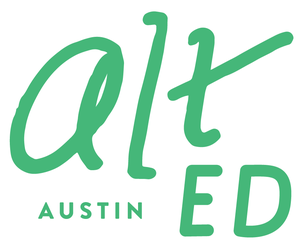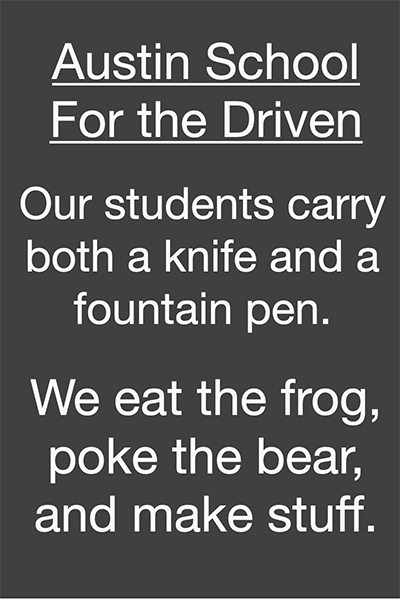The “write” way
/Melissa “Missy” Menzes is an occupational therapist and founder of Extra Credit! LLC. She is passionate about and highly successful at serving children in our community who have “fallen through the cracks” at school. Today she returns as our guest to give parents some insight and practical advice on supporting children with handwriting difficulties.
Handwriting help is, by far, the most common reason for referral at Extra Credit! LLC. I thought it might be helpful to address some of the most frequent questions we get with some developmental background and quick tips. The summer is a great time to work on these issues. For more specific help, a free handwriting screening, or formal assessment, contact missy@extracreditaustin.com.
Hand Use
Developmental Background: Bilaterality, or alternating hand use, occurs at 2–3 years. Lateral preference, or being able to use one side of the body more proficiently than the other, is usually achieved by age 3–4. Between 4 and 6 years, children develop more unilateral abilities. Developing a preference assists with directional concepts, brain hemisphere specialization, and refinement of manual skills. Hand dominance, or a strong consistency to use one hand during task-oriented activities, typically occurs between 6 and 7 years of age. By age 7–8 children should know left and right sides of their bodies well. Well-integrated dominance does not always occur until 8–9 years in many children. “Mixed Use/Dominance” is often due to lack of proximal stability or endurance, poor bilateral integration, and problems in manual dexterity. It is quite common with children who have learning disorders. True biological-based ambidexterity is quite rare and often has a genetic basis.
Quick Tips: Encourage awareness of both sides of the body and of directions by playing games like Hokey Pokey, Twister, Hop Scotch, and Simon Says. Have child pick the hand they want to use during a task and do not allow switching in the middle of the task. Place objects to either side of the body midline and spread out to encourage rotation of the trunk to help reaching across with the opposite hand. Sit on varying sides of a child and have them move around so that there is not unintended positional bias toward the child using one hand over the other. Put a watch or bracelet on the writing hand as a tactile cue, and use cognitive-recall strategies such as “I write with my right hand.” (Note: Left-handedness can bring a lot more challenges. I would recommend contacting us for support if you have a left-handed writer who is struggling and needs assistance.)
Pencil Grasp
Developmental Background: A fisted grasp is typical from 1–1.5 years. From age 2–3 a brush-style grasp is common; here, the arm is in the air and the pointer finger is extended toward the tip of the writing utensil. Next, typically a static (moving wrist, stationary fingers) pattern in opposition to the thumb is common and then a dynamic (moving fingers, stationary wrist) pattern with four fingers resting against the tool (quadropod). By 3.5 to 4 years, three fingers of stability are more common (tripod). A mature, efficient dynamic tripod grip is expected by 4.5 to 6 years of development. The dynamic tripod offers the best mechanical advantage for writing small and controlled letters for a long time. If a child has joint hypermobility or poor proximal stability, he or she will seek positions of best stability for comfort and endurance, but problems arise when this method causes pain, discomfort, fatigue, or joint deformity. Several specific developmental skills are needed before a mature grasp can be achieved. Research has proven that there are four grasp patterns that are considered functional for writing (static and dynamic tripod and quadropod grips). After around second grade or age 7, research says that a grasp pattern is locked in and cannot usually be successfully changed without external remedial supports (such as an adaptive pencil grip or tool).
Quick Tips: Using small pieces of crayons or chalk often encourages a three-finger grasp pattern. Drawing at vertical surfaces facilitates a wrist action called tenodesis that mimics the tripod grasp and improves wrist and shoulder proximal stability necessary for better distal fine motor control. Golf-sized pencils are better for kindergarten-sized hands. Squirt bottles, scissors, and climbing/hanging encourage opposition of the thumb and strengthen the hand arches. Fine motor activities with beads, bands, lacing, pinching, twisting, tool use, and manipulatives all improve strength and coordination useful in maturing grasp patterns. (Note: There are many commercial grips and a few tools that can help improve efficiency in an older child, but I would suggest working with an occupational therapist for best success with grip accommodation strategies. These options usually don’t work well unless done right, and sometimes a developmental hand program is needed before remedial options should be introduced.)
Reversals
Developmental Background: It’s not unusual or uncommon for preschoolers and kindergarteners to reverse several letters and numbers. By age 6, children should write capital and lowercase letters and numbers 1–9 with 85 percent correct orientation. By age 7, symbol accuracy should be 90 percent, and by age 8–9, 100 percent correct orientation is a suggested target. In many cases, reversals are either due to problems with spatial orientation, laterality, start, or sequencing of symbols. Children age 5–6 should identify their own left/right limbs with 75 percent accuracy. Children 7 and above should begin to identify what side objects are in relationship to each other, and typically by age 9 kids can understand lateral concepts on other people. When shown a mixture of reversed and correctly oriented symbols, children age 5 will typically make numerous mistakes identifying what is correct, but by ages 9–10 such recognition errors should be highly accurate.
Quick Tips: To reduce symbol reversals, teach correct start and sequence with a multisensory program (hear, see, feel, do big) and provide a visual letter template so that kids can compare work for editing. Worksheets and free writing without close facilitation are never encouraged because this is where young kids develop so many bad habits that go “unseen.” Kids often draw symbols in incorrect sequences or with inconsistent patterns and never get an appropriate motor memory of the correct formation, which is a necessary foundation to advancements in writing. Handwriting Without Tears uses several methods that help reduce reversals. Play “Mystery Letter” by drawing on the back or in the air or on something textured with the finger. Kids will recognize mistakes more quickly in these ways than in small works or in words. (Note: Sometimes reversals may indicate the need for additional screening. They can be symptoms of a visual or neuro-based condition.)
“Other”
Writing has a lot of important benefits, and no matter how much our society advances toward communicating with digital technology, the importance of legible and functional writing skills should never be overlooked. Kids should learn print and cursive and then focus on the one that suits his/her best before adding “flair.” I think it makes the most sense to begin with a solid foundation in print and then to add cursive. Some children do best with a vertical style, while a few others do better with a slanted one. Each child is different; there is no one way that is best for everyone.
When it comes to recommending a specific curriculum, I prefer Handwriting Without Tears because of its heavy emphasis on multisensory, kinesthetic, and developmentally appropriate instruction. I also like that the print, cursive, and keyboarding programs all reinforce each other. If done correctly, the kids should be working with fine motor manipulatives, grip, and learning formation through fun songs and games before even doing pencil-paper lessons. The double-lined paper is excellent for kids with visual-spatial-organization difficulties, and the workbooks reinforce early literacy and are not biased to the right-handed child.
I have been trained in several great programs and am certified in handwriting. As an occupational therapist, I naturally combine the best of all and give it my own spin. I always find success when something is fun, active, repetitive, meaningful, individualized, and the “just right” challenge.
Another major helper, as weird as it may sound, is music. More than anything else, I and my clients have truly been amazed by what sound therapy (even if purely home-based) can do for legibility. I’m not a sound engineer, but I have been trained in five different sound therapy approaches, and while they are each unique, the concepts and results are basically the same. Some programs are just a little more accessible or appropriate than others.
Lastly, when all else fails, I like to encourage exploration of assistive technology. With a few simple and modern supports, I have seen kids go from failing to passing homework assignments. Others have transitioned from hating writing to loving it. Who knows, maybe like one of my last kiddos, yours will be the next great author! The point is, sometimes a little support can go a long way, and it’s not about giving up; it’s about emphasizing strengths and leveling the playing field.
Melissa “Missy” Menzes, OTR






















